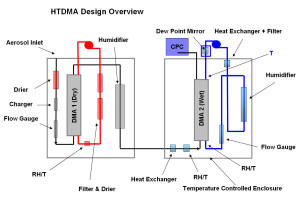Hygroscopic Tandem Differential Mobility Analyser (HTDMA)
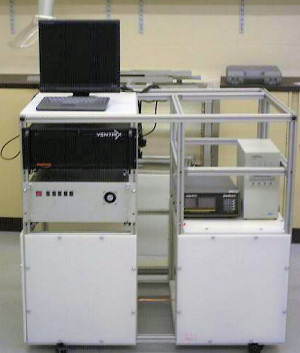
The Hygroscopic Tandem Differential Mobility Analyser (HTDMA) is designed to measure size resolved aerosol hygroscopic properties. Hygroscopic properties refer to how an aerosol population responds to a change in relative humidity. A particle's response to a change in humidity say from 10 to 90% is a function of it's size and chemical composition. Soluble particles take on water and grow with increasing humidity, while particles composed of hydrophobic material do not. The amount of growth which takes place also depends on size according to the Kelvin effect, so small particles grow less than larger ones. The ratio of the wet and dry diameters is referred to as the particle's growth factor.
A particle's response to changing relative humidity (assuming it responds at all) is generally somewhat non-linear. For example, most inorganic salts grow very little with increasing relative humidity until their deliquescence point is reached (the RH at which the particle changes from crystalline to liquid form) after which significant growth with increased RH takes place. However, when RH is decreased below the deliquescence point, most salts exhibit hysterisis, that is they do not immediately re-crystalise, but continue to shrink, remaining as supersaturated liquid drops until their effervescence point is reached.
General Information and Technical Specification
The Centre's HTDMA has been developed in house, by Mike Cubison, Martin Gysel and Nick Good, under the direction of Professor Hugh Coe, Dr Martin Gallagher and Dr Gordon McFiggans. The first version of the instrument underwent initial field trials during the NAMBLEX project at Mace Head, Ireland during August 2002. Since then the instrument has been modified somewhat, and has been operated on a number of other field and lab projects around the world. Recently a second instrument has been constructed to cope with growing field and lab demands. The new instrument should also have improved measurement capabilities, such as faster scan times, and better reliability.
Both systems have the following general specifications:
Total Possible Dry Size Range approx 20-500nm - Maximum Wet Size >1000nm
Humidity Control of DMA's +-1%
Standard Operation - Dry DMA 10%RH, Wet DMA 90%RH
Humidogram Scans Possible
Particle Concentration Range - 100's - 100,000's /cc Dependant on dry size distribution.
Typical Scan Time ~ 1 hour.
Principle of Operation
The HTDMA is composed of two Differential Mobility Analysers (DMA) (see description on DMPS page for DMA details), a particle counter, and various pumps and humidity control devices etc. In this instrument, the DMA's are used in series. A poly disperse aerosol distribution at ambient relative humidity enters the system, and is dried as it enters DMA-1 (RH < 10%). DMA-1 is used to select a mono disperse distribution of a given size. Aerosol exiting DMA-1 is humidified and then enters DMA-2 (which also has humidified sheath air). DMA-2 coupled with the particle counter (a TSI model 3760) is used to measure the size distribution of the humidified 'mono disperse' aerosol, hence providing a growth factor spectrum.
The HTDMA has two modes of operation – constant humidity and varying humidity. In constant humidity mode, a given dry size is selected using the first DMA, then this aerosol is humidified to 90% RH, and the resulting distribution measured with the second DMA. Thus the growth factor/s of this aerosol size is obtained. Different dry sizes are selected in turn to build up a size resolved set of growth factors for the aerosol distribution. In varying humidity mode, a single dry size is selected, and the humidity of the second DMA is increased in steps from about 30 – 90%, and for each step the humidified distribution measured. Thus a humidogram for the selected aerosol size is produced.
Some Sample Results
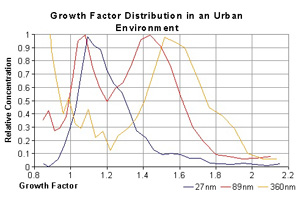
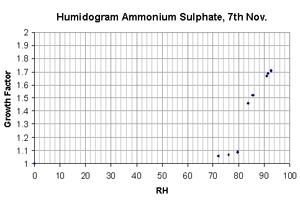
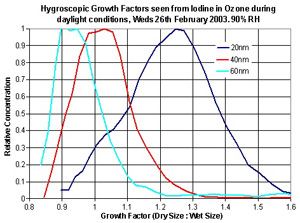
Figure 1 shows a combination of growth factor distributions for three dry sizes, typical of the urban environment. The smallest sizes (40nm) are almost entirely hydrophobic, having now high growth factor mode. At 89nm there are two distinct modes, one hydrophobic, and one more hygroscopic, but the more hygroscopic mode still has a growth factor significantly less than that of an inorganic salt. However for 360nm particles, there is a single hygroscopic mode at a growth factor approaching that of an inorganic salt. This HTDMA data complements AMS measurements which show the smallest particles to be almost all organic carbons, with increasing amounts of inorganic material at larger sizes. These HTDMA measurements also suggest that at 89nm organic and inorganic components are externally mixed, while at 360nm they are internally mixed.
The varying humidity mode has been used for lab tests on the capability and accuracy of the instrument and to produce humidograms of ambient aerosol. Figure 2 shows a measured humidogram for nebulized Ammonium Sulphate, and shows that it’s measured hygroscopic properties match the standard values, ie a deliquescence point of 80% RH, and a growth factor of 1.67 at 90% RH.
On some occasions growth factors of less than 1 have been observed, this is rather unusual, but an example is shown in figure 3. The aerosol distribution was produced in the lab during some recent iodine photochemistry experiments. It is expected that these particles had a fractal structure, and that when water is taken up by such particles the structure collapses and the particles shrink.
HTDMA Project Involvement
Publications using HTDMA data
The HTDMA is supported by the NCAS Facility for Ground-based Atmospheric Measurement (FGAM).
